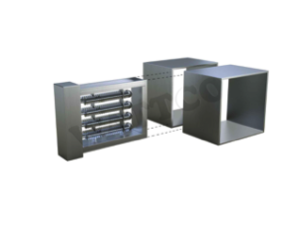Duct Heating in HVAC and Building Construction
Last updated on April 25th, 2025 at 05:36 am
Heating, ventilation, and air-conditioning (HVAC) systems are used for heating and cooling residential, commercial, and industrial buildings. Aside from helping ensure the comfort of those residing in these spaces; HVAC can also help in diluting airborne contaminants by providing fresh outdoor air. Wattco’s Duct Heaters can be used for heating across the commercial and industrial spectrum. HVAC systems generally have basic design elements, like an outside air intake and an air handling unit that consists of a system of fans, heating and cooling coils, and air filters. There’s also an air distribution system and air exhaust system. Part of the air distribution system is the duct system, which provides the controlled path for the air to flow throughout the home, commercial space or factory.
It consists of a branching network of round or rectangular tubes which may be made out of materials like sheet metal, fiberglass duct board, and insulated plastic. These tubes are located within the walls, floors, and ceilings.
Electric Duct Heater uses
An integral part of the duct system is the electric duct heater which makes use of electricity to warm the air that passes through a duct. It consists of a heating element which converts the electricity into heat through resistance. The resulting heat is transferred by conduction or convection to the air passing through the device.
These duct heaters can be used for space, supplementary, and primary heating applications. Electric duct heaters are particularly valued for helping achieve energy efficiency for cold rooms. These devices monitor temperatures and automatically modify heat output accordingly to maintain the ideal temperature of the open coil element.
Electric duct heaters can be programmed in such a way that they can heat up the area at a specific point in time. This results to efficient heat transfer without wasting energy as the room or space is only heated for the required times. Electric duct heaters in HVACs can complement the heating of homes and offices by preheating fresh air or returned air. Most of the modern electric duct heaters are equipped with a modulating controller that facilitates operation in extremely low air flow without compromising performance.
Installation and Features
These devices may be installed in ceilings of office buildings, schools, churches accommodation areas of sea going vessels, and other establishments. They may also be used in power plants and wastewater facilities and commercial constructions. Duct heaters are relatively easy to install, whether it is for a new project or to replace an old one because every heater is designed according to a current dimension, wattage, and current.
Mounting can be done by welding or by flanges. Most electric duct heaters in HVACs have features like an air flow cut-off switch that can ensure air flow across heating elements occurs evenly. If one element receives too much or little air, then the system adjusts. Another typical feature is an automatic, primary thermal cut-off that will stop the unit whenever the temperature limit has been reached.
Secondary thermal cut-off is another standard feature which enables qualified personnel to stop the unit manually when the high temperature limit is reached. There are also electric duct heaters that are designed for installation in hazardous areas. These heaters feature temperature control and are used in applications like ship construction, chemical and petrol chemical installations etc.
